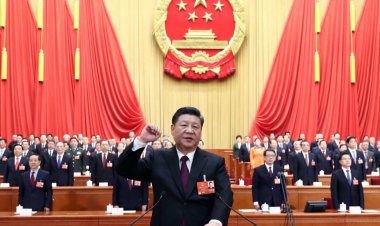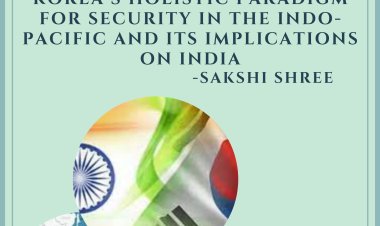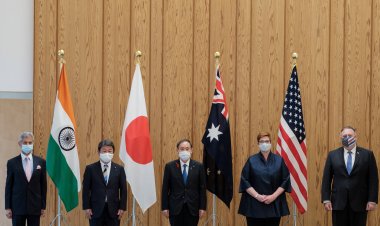The United States of America & China: Era of Conflict or Cooperation?
In this article, the author analyses the collaboration and divergences between US and China. They also discussed how good ties between the two nations may benefit the world and how both countries approach their interactions over significant global challenges.

Analysis
By Monika and Mohd Amin Khan
(French military leader Napoleon Bonaparte once said, “China is a sleeping giant and let her sleep, once she wakes, she will shake the world………………………….”)
China entered the international community as an independent country in 1949. The United States and China have one of the most significant and challenging bilateral partnerships globally. Since 1949, the countries have experienced conflicting and cooperative periods about trade, climate change, and Taiwan. In 1972, United States president Richard Nixon made a trip to China. He wanted to normalize ties between both countries. Both nations cooperate and forge close relationships to overcome their strategic mistrust. The linkages to the economy developed quickly after 1980. Both China and the United States are vying for positions of global prominence. China is attempting to erode the US hegemony as evidenced by its policy shift, proactive diplomacy, and economic assistance to weaker and developing nations, particularly in areas where the US enjoys a significant geographic advantage. Most academics see US-China relations favorably and believe that global benefits will result if both countries address global problems like terrorism and environmental degradation. However, some scholars define their relationship as a threat to international security. The mistrust and dissatisfaction in their relationship will harm the whole world. In this essay, we'll examine their collaboration and ideological divergences. We will also discuss how good ties between the two nations may benefit the world. We will also go into more detail on how both countries approach their interactions over significant global challenges.
Stability factor and Fundamental cooperation
David. M. Lampton talks about emerging US and China relationship trends. Primarily focusing on the policy and decisions under the presidency of Obama, he elaborated on a description of the changing hierarchical structure of the world where Washington is no more a single power and dominant. The geopolitics of the world has drastically changed just in two decades. New emerging powers such as Russia, China, and India are limiting the hegemony of the US over the world. In this changing situation, the US should also change its fundamental attitude according to the ongoing circumstances. The US-China relations seem more fundamental, and both states should have benefited from this by working together on global problems. The idea of stabilization forwards the common interest that supports US-China relations. Also, the formulation of G-2 was a significant step in this as G-2 propounded the concept of global economic stabilization, global ecological stabilization, and security stabilization to be cooperative coalition builders. A convergence of strategic circumstances, domestic leadership, and public opinion in both countries has created an environment conducive to fundamental stability. Both nations are preoccupied with their domestic problems and motivated to minimize the drain of foreign entanglements. They have domestic reform agendas of similarly sweeping scope (building or rebuilding the middle class, strengthening the social safety net, reforming education, financial institutions, and health care delivery), which helped in creating a jointly shared predisposition to avoid problems. Both countries define public opinion, appoint high-level positions, and dialogue to continue with bilaterals. The general opinion setting of the US-China has negative and positive dimensions, but this setting is not the driving force of policy between both nations. The cooperative stage has four global issues. The first ever is climate change, where Bejing thinks that the consequences of Global Warming will hurt both countries as they are working on a G-2 roadmap for US-China Cooperation on Energy and Climate Change. Secondly, both countries are working on a 'new' global economic architecture and protectionist fears; thirdly, they are dealing with counter-proliferation, failed states, and mutual strategic mistrust. And lastly, the US and China are cooperating on the issues of recognition of Taiwan and Tibet. But the recent visit of US speaker Nancy Pelosi to Taiwan further escalates the tensions between both countries. Somehow it provoked China and gave her an excuse to do continuous military drilling around the Taiwan region.
Strategic rivalry or Balance of Power
Both the US and China are well equipped to destroy each other. Neither the US nor China is a single dominant power in the world, so a stable balance of power is needed to avoid rivalry and prevent their ties from turning into a cold war. A big power model propounded by Xi Jinping could prove a better alternative to carry on with this policy. Sushang Zhao elaborated on how the Big power model will be beneficial for both of these countries. Instead of getting into Thucydides' trap China and the US should adopt big power relations. China is rising and expanding its legs everywhere, including the Asia- Pacific region and where the US has been dominant since the aftermath of the cold war. This will further escalate the Cold War between both countries, which will soon boil. The US and China should work together and maintain a delicate balance of power to prevent rivalry. Another perspective emerges from realists emphasizing that China should seek regional dominance and hegemony in the Asia-pacific region. China's hide-out policy and isolation policy helped strengthen her nation-building. Slowly and gradually, China started noticing Washington's activities in the South China sea, in Taiwan, and especially in China's periphery region as a threat to China's national integration. China's territorial claims and her unusual position and domination acts fueled ongoing tension between both countries. China realizes that to be a global power, it is important to cut the edges of US dominance, called 'cutting skirt edges.' It is crucial to De- Americanization of the world and must adopt host diplomacy. In February 2022, the US government unveiled its Indo-Pacific Strategy, which details its regional strategic priorities based on the "Free and Open Indo-Pacific" idea. The United States will use its network of partners with similar interests and security concerns, which it calls its "single greatest asymmetric asset." To combat this, the Chinese government announced the creation of a store of emergency supplies, a China-Pacific Centre on Climate Change Cooperation, and a Centre on Poverty Reduction and Development Cooperation. China also emphasized Xi's idea of creating a "Community of Common Destiny" and enlisted the assistance of Pacific island nations on the problems with Taiwan, Hong Kong, Xinjiang, and Tibet.
Approaching China’s rise
The containment of China's rise is not a viable option policy. We need to adopt three crucial points for the US to respond strategically to China's rise. The first is to ignore it, the second contains it as exemplified, and the third is to accept it. The unilateral attempts to control China by the US will lead to self-defeating because of its trading partners, Asia-Pacific commitment, diffusion of power, underscore of strategic rebalance, lack of close Asia ties, and isolationism. Hence both countries agreed on shared goal development and cooperative and constructive management of differences with the Big power model. Both nations decided upon balancing the relation specifically in the Asia-pacific region as opposed to a single dominant position and adopted the strategy of mutually assured restraint. But somehow, they failed in perfect balancing and could not prevent themselves from falling into the Thucydides trap. This Asia- pacific region was the testing ground of their balanced relationship, which shows that this big power model is not that cooperative. Strategic mistrust, frictive acts, and lack of empathy have core space in the policies of both countries. But the United States is also anticipated to assist "soft sectors" in the region, such as women's empowerment, anti-corruption, promotion of media freedom, civil society engagement, human rights, and development, in striking contrast to China. To cover up the Chinese effect, the US has tried every possible way to establish close ties with China's periphery. The US also realized that we should adopt a redistributive, revisionist approach and edge-cutting policies to tackle China's rise instead of harsh policies. However, China is also trying every possible way and still maintains its realist position towards limiting US hegemony and dominance over the world.
Since Biden's victory in the United States, the political and commercial stakeholders have been closely monitoring the path of the new White House administration's policy toward China. In July 2022, US president Joe Biden and Chinese President Xi held a two-hour call in which they discussed cooperation between the two countries and issues surrounding Taiwan and Ukraine, including other global matters. Later, Pelosi's visit to Taiwan triggered military exercises, which provoked Beijing to halt China-US negotiations over the recent climate issues. Recently China's Foreign minister met with its US counterpart on the sidelines of the UN General Assembly at G20 Foreign Minister’s Meeting, which was held on July 2022. After this, the United States released a statement that the US is committed to maintaining peace and stability across the Taiwan Strait, consistent with the longstanding one-China policy.
Hereby we see that both nations are aware of each other's potential and continuously strive to minimize their disparities. No doubt that the United States and China share crucial bilaterals, and how this relationship evolves will determine how the globe will look in the twenty-first century. Both Presidents concur that they should maintain the positive China-U.S. relationship. They both agree that the two nations should have no hostility or strife. Additionally, they both support expanding bilateral communication and cooperation. President Biden stressed numerous times that the United States does not favour "Taiwan independence," it does not desire to alter China's political system, it does not seek to restart the Cold War with China, and it does not seek to engage in combat with China. Through cooperation, both can work on various global issues such as terrorism, forced migration, refugee resettlement, cyber warfare & securities, global warming, Climate change, etc.
Disclaimer: This paper is the author's individual scholastic contribution and does not necessarily reflect the organization's viewpoint.
Mohd Amin khan is a Ph.D. scholar at the Indian Institute of Technology. He is interested in research and academic writing. His inquisitive domain includes political geography, global affairs, environment, and geospatial analysis using GIS. He has also worked as an Asst. Project Manager at IIT Kanpur and Project Assistant at IIT Roorkee.























